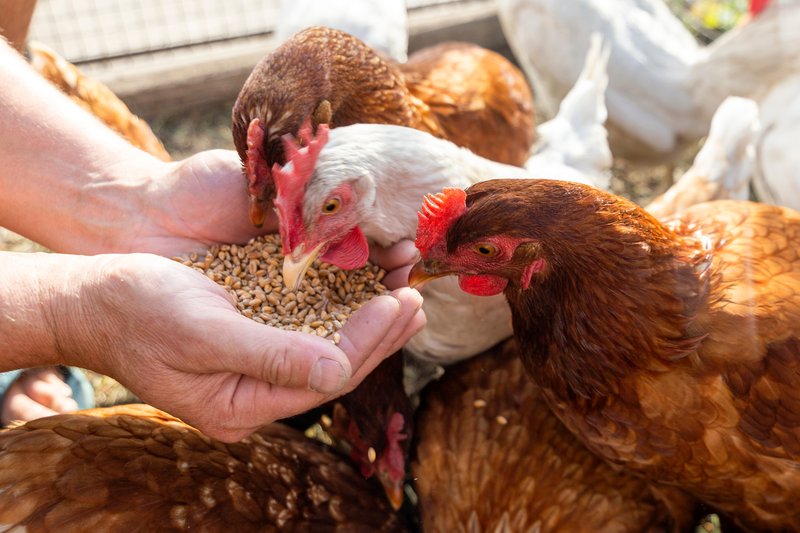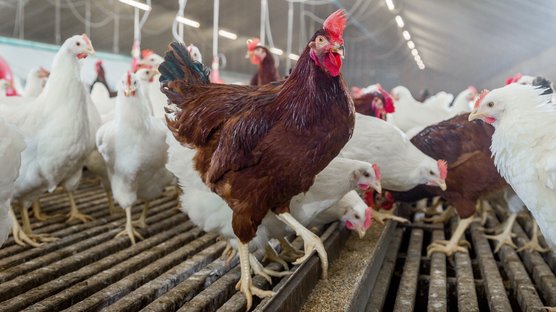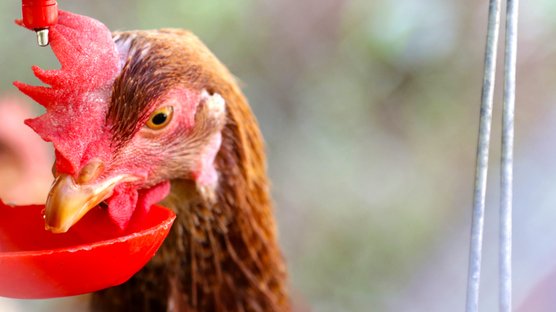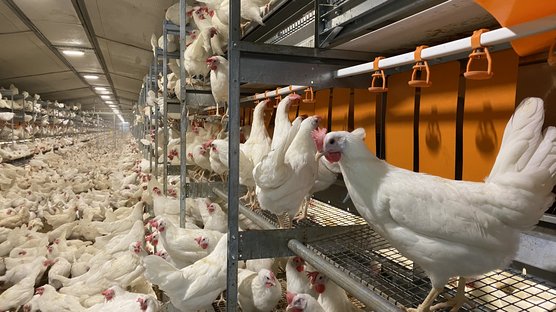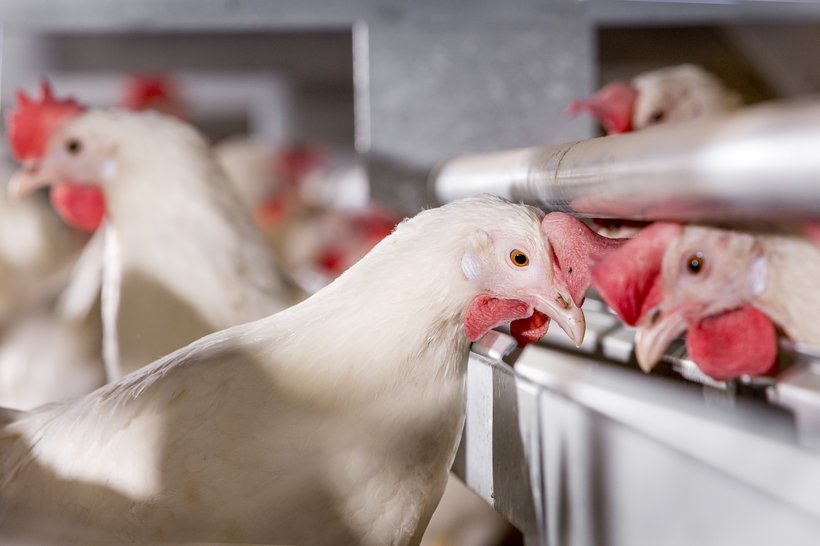
Published on March 2, 2023
Controlling costs through the use of alternative ingredients in poultry diets
Egg producers strive to produce a nutritious, versatile, safe and economical feed. In this sense, nutrition (represents more than 50% of the production costs of an egg) can contribute in controlling production costs by optimizing the use of alternative ingredients in search of feed conversion and housed eggs with top quality.
Egg production depends on the balance between production costs and the value paid by the consumer. Throughout recent history, several factors have increased production costs, increasing the pressure on egg producers to remain competitive in the egg market.
Traditionally, the most used feed ingredients are corn, soybean meal, wheat, and oats. However, the dispute between food and feed is becoming increasingly fierce and associated with the concern for reducing environmental impacts. Fortunately, genetic selection of laying hens have contributed a lot as the hens have been selected to adapt to the different types of chicken feed available to them.
In different regions of the world, "alternative" ingredients such as sorghum, millet, triticale, sunflower meal, peanut meal, rice bran, palm meal, cottonseed meal, linseed meal, fish meal, etc. are available. More recently, the corn-based ethanol industry has generated DDG (Distillers dried grains); residues from the bakery industry have also been used (bread and cracker meal) and research continues on the use of insects (live or in the form of meal or oil) as feed for laying hens. In addition, research is being conducted with microalgae, legumes of the most varied types (such as field beans), and products that increase the use of phosphorus from ingredients of vegetable origin have also been developed.
The use of alternative ingredients to control feed costs is possible, feasible, and necessary. Therefore, each new ingredient has different qualities to be used and limitations to be respected.
It may seem laborious, but there are important points to be considered so that we can promote productivity with quality and controlled production costs. Below we have listed several points of attention that facilitate the use of alternative chicken feed ingredients.
- Bromatological quality of the raw material: The quality of the raw material influences the final cost of the feed. For example, the same raw material, with the same price, but with different nutritional levels will result in a feed with a higher cost, the worse the nutritional quality of this ingredient is. Routine analysis of raw materials and selection of your suppliers minimizes undesirable variations.
- Product quality compared to reference products: When studying the use of alternative ingredients, keep in mind that some of these "new" ingredients may have lower nutritional values compared to the "reference" ingredients (such as corn and soybean meal) and this affects the dynamics of the feed formulation. Simulation of different formulations is the way to clarify these doubts.
- Nutrient matrix of alternative ingredients: The more accurate the knowledge about the nutrient matrix of the ingredient and the greater the synchrony between the information in the feed formulation and what the chicken is consuming, the lower the chances of yield losses. Determining nutrient digestibility is necessary because the nutritionist relies on digestible nutrients (such as amino acids).
- Inclusion rates: The gradual use (gradual increase) of these ingredients reduces the possibility of performance losses, especially when we do not have sufficient information about their nutritional characteristics. For inputs with a maximum use recommendation of 5%, a gradual increase of 1%, 3% and 5% is recommended. For inputs with a maximum recommendation of 30%, a gradual increase of 10%, 20% and 30% is recommended. Keep an eye on batch performance within 2-3 weeks of any change in the dietary formula.
- Price: together with the nutritional matrix of the ingredients is the determining factor for use in feed formulation. Feed formulation programs are based on minimum cost formulation. Therefore, if the value paid for the nutrients contained in the different ingredients is not attractive, the feed formulation program will not use the ingredient under study. It is important to keep the nutritionist informed about the price variations of the inputs.
- Quantity available for use: the availability of inputs is important for the feed mill operations and the achievement of lower production costs. The monthly volume available for purchase can determine the maximum inclusion rate. If there is limited availability for purchase, one can choose to maintain the maximum inclusion for a shorter period of use or limit the inclusion rate to use the ingredient for a longer period. These different scenarios can be analyzed through the feed formulation.
- Stability of the nutritional pattern of the input: for each of the nutrients there are tolerance limits for upward and downward fluctuations and the consequences for the chickens of these fluctuations are known. For example, when we formulate a laying feed for chickens and we consider that we are using soybean meal with 45% of Crude Protein for a formulation with 17% of Crude Protein, but we are receiving and using soybean meal with 40% of Crude Protein and we do not adjust the formulation, we run the risk of offering the hens a lower protein content (for example 15% or less) which we gcan cause loss of productivity. Therefore, monitoring the quality of raw materials is important to minimize risks and helps to establish safe levels of use.
- Storage care and shelf life: storage care is also required (such as protection from direct sunlight, in a dry and ventilated place), some characteristics of the ingredients may require greater care during storage. The smaller the particle size and the denser the ingredient, the lower the aeration rate and the greater the possibility of this ingredient accumulating in corners in storage rooms. The higher the moisture content, the greater the possibility of proliferation of undesirable microorganisms (bacteria and fungi). If the saturated fat content in oils and fats is on the high side, they may require heating for fluidity in the dosing system. But constant heating can increase fat oxidation rates. All these factors need to be monitored and adjusted in feed mill operations.
- Operational characteristics in the feed mill: When using alternative raw materials, it is necessary to have a structure in the feed mill that allows the receipt, storage and dosage of these items. With this, structural adaptations (more storage silos, more dosing silos, liquid dosing systems) are necessary so that the new ingredients can be used.
- Inclusion level at different ages: The general recommendations are to avoid the use of alternative ingredients in very young chickens (less than 5 weeks of age) because the gastrointestinal system of chickens at this stage is in the process of development and possible problems at this stage can generate consequences during the weeks that follow. For laying hens in production, the use should aim for the maximum recommended dosage. It is recommended to carefully monitor the performance of the flock, especially as hens get older.
- Ingredient particle size: A chicken has greater difficulty in grasping very fine and/or extremely coarse feed particles (such as whole corn kernels). Therefore, the physical presentation of the ingredients should be taken into consideration. For example, millet can be offered whole to chickens, while sorghum requires grinding (like corn) but allowing a percentage of whole grains (around 20% of the volume used) to be present in the feed. In addition, we must also be careful with very fine ingredients, as they may impair the feed granulometry (stimulate feed selectivity) and present dispersion problems (lump formation). It is recommended to monitor the physical appearance of the product and how it behaves in the chicken feed.
- Ingredient processing: It is possible that the new ingredient in the "raw" state may not be able to provide the nutrients needed for feasibility. It is possible that some ingredients may need further processing (such as cooking, finer grinding, drying, etc.) to increase the availability of nutrients to the hens or to neutralize some anti-nutritional factor. More research is needed after these alternative ingredients.
- Presence of anti-nutritional factors: these factors (e.g., trypsin inhibiting factors, non-starch polysaccharides, gossypol, tannin, mycotoxins, phytates, oxalates, oxidized fats) are responsible for reducing the rate of utilization of the nutrients contained in the ingredient and cause losses in productivity and egg quality. All these factors (and other new ones specific to each ingredient) limit the maximum inclusion rate of the ingredients and can cause flock productivity losses. Fortunately, there are additives that help us minimize their damaging effects, such as enzymes, mycotoxin adsorbers and antioxidants.
- Strategic use of feed additives: The feed additives that we currently use were developed based on traditional ingredients. We are considering enzymes, probiotics, essential oils, vitamins, among others. With this, it is possible that new studies related to the use of these additives will allow a better use of the nutrients contained in alternative ingredients. The complementation of these may help to control alterations in the intestinal flora, and vitamin deficiencies resulting from the use of alternative chicken feed ingredients.
- Presence of pigmentation in the feed: The consumer has preferences regarding yolk coloration. Some ingredients favor a more orange yolk (e.g. corn, alfalfa) but some ingredients lack carotenoids (e.g. sorghum, millet, rice) and this may generate an additional demand for pigment (natural or artificial) to keep the yolk attractive to the consumer. The use of the different pigmenting agents available on the market is adjustable to each situation at hand.
| Ingredient | Inclusion rate (%) | Ingredient | Inclusion rate (%) |
|---|---|---|---|
| Algaroba meal | 3 – 10 | Rice bran | 3 – 12 |
| Cottonseed meal | 2 – 5 | Rice grits | 30 – 65 |
| Peanut meal | 3 – 10 | Oat bran | 5 – 10 |
| Babassu meal | 3 – 8 | Cookie by-product | 5 - 15 |
| Canola meal | 1 – 4 | Rye | 4 – 15 |
| Coconut meal | 3 – 8 | Barley | 8 – 20 |
| Sunflower meal | 5 – 15 | Millet | 15 – 45 |
| Cassava meal | 5 – 20 | Corn germ meal | 5 – 20 |
| Corn gluten meal | 3 – 10 | Bread by-product | 10 – 25 |
| Fish meal | 3 – 5 | Soybean hulls | 0 – 5 |
| Wheat meal | 3 – 15 | Sorghum | 15 – 65 |
| Triticale | 10 – 30 | Wheat | 12 – 30 |
| Soybean meal | 0 – 35 | Corn | 0 – 65 |
It is always worth remembering the importance of partnerships between the poultry feed sector, the egg industry and research institutions, as through research it is possible to establish the criteria for use of the different types of ingredients that are available on the market before implementation in commercial chicken feed.
Hendrix Genetics continues to select laying hens capable of producing well, in terms of productivity (egg numbers) and egg quality. At Pure Line level, the laying hens are being subjected to the different alternative feed ingredients available, which allows the breeding company to select the laying hens capable of coping with these alternative diets. Partnerships with feed companies and research centers exist to increase the amount of applicable knowledge for the poultry sector. A team of technical experts is available to guide egg producers and feed mills in the continuous search for setting the standard, cost control, product quality and profitability, all contributing towards sustainable egg production.
